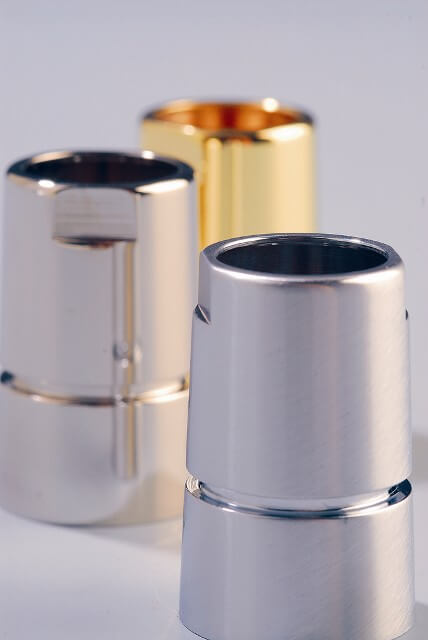Galvanic nickel plating - the process
Nickel plating is one of the oldest processes in electroplating and is mainly used as an undercoat for other processes, such as chrome plating. If a significant improvement in corrosion protection is required in the coating system, nickel proves to be an adequate surface finish. Due to its universal applicability, it has become indispensable in both the decorative and technical fields.
Advantages of galvanic nickel plating
- Good resistance to acids and alkalis
- Parts can also be soldered or welded after coating
- Corrosion protection (from 20 µm layer thickness) over a wider temperature range
- Nickel-plated component has ferromagnetic properties
- Wide range of applications from decorative to functional
- Improves the wear resistance of the coated component

Where is galvanic nickel plating used?
Industrial application
Restoration
Decorative products
Are you looking for a partner for nickel plating?
Then contact us now.
We look forward to being able to process your request individually.
Technical specifications
| Materials: | Steel, brass, copper, bronze, stainless steel, aluminum. Zinc die casting |
| Plant capacity: | 500 x 300 x 150 mm (oversize by arrangement) |
| System technology: | Frame, drum |
| Production guidelines: | RoHS, REACH, 2000/53/EC (end-of-life vehicles) |
| Execution | glossy, matt |
| Layer thickness | 8 - 25 µm |

Why choose TECHNO-COAT?

Everything from a single source
Nickel is the base or intermediate layer for many surface finishes. We offer you numerous suitable combination layers from a single source.
Speed
Do you need to nickel plate your products quickly? Then we are the people to contact! Thanks to our smooth processes, we are able to coat your products in a short time.
Many years of experience
On the market for over 25 years! We put all our experience into the finishing of your products.
High quality standards
Through internal testing procedures and our DIN ISO 9001 certification, we have been guaranteeing consistently high quality for years.
How we nickel plate - the process
1
Pre-treatment
Depending on the delivery condition, pre-treatment may be necessary to remove unwanted contamination or residues from previous processes. For this purpose, the parts are processed in an ultrasonic cleaning system.
2
Decoction degreasing
A further cleaning step takes place in the boil-off degreasing process. This removes the last residues that may not have been removed during ultrasonic cleaning.
3
Cascade sink
The chemical residues of the degreasing/cleaning process are neutralized. This step is repeated during the process.
4
Pickling
The metal surface is freed from existing corrosion. Various additives ensure that the base material is largely unaffected.
5
Electrolytic degreasing
Electrolysis creates small bubbles on the surface. These cause fine cleaning by blasting off dirt particles.
6
Activation
This process step removes existing passive layers and activates the surface for the subsequent coating.
7
Nickel plating
Pure nickel is brought into solution by electrolysis and deposited as a nickel layer on the component to be coated by excess electrons via an aqueous phase.
8
Combination layer
After nickel plating, either a further galvanic coating, e.g. chrome plating, and/or a PVD coating can be applied directly.
9
Drying
The copper-plated product is dried with hot air in the circulating air dryer.
Frequently asked questions
What are the advantages of nickel plating?
Nickel improves numerous properties of the base material and offers the following advantages in a wide range of applications:
- Good resistance to acids and alkalis
- Component remains solderable and weldable
- ferromagnetic properties
- Targeted protection against wear
What are the disadvantages of nickel plating?
Nickel as a surface finish has the following disadvantages:
- Corrosion protection is only achieved from a layer thickness of 20 µm
Which materials can be nickel-plated?
Copper, brass, bronze, steel and stainless steel are mainly suitable for nickel plating.
What investment capacities are available?
Our system capacity is 500 x 300 x 150 mm. We can also coat larger components by arrangement. Just ask us about this.
Which system technology is used for nickel plating?
Various racks and a drum for bulk material are available for nickel plating.
Which manufacturing guidelines are adhered to?
We adhere to the following production guidelines for nickel plating:
- RoHS
- REACH
- 2000/53/EC (end-of-life vehicles)
Request now
Send us your request simply and conveniently using the form. You will receive our information on the coating process directly afterwards. If you are not sure about certain details, please contact us directly by e-mail or telephone or leave the fields blank.
We look forward to receiving your inquiry!
Your contact person

- Reiko Röthig
- r.roethig@techno-coat.com
- +49 (0) 3583 / 77 21 - 34
